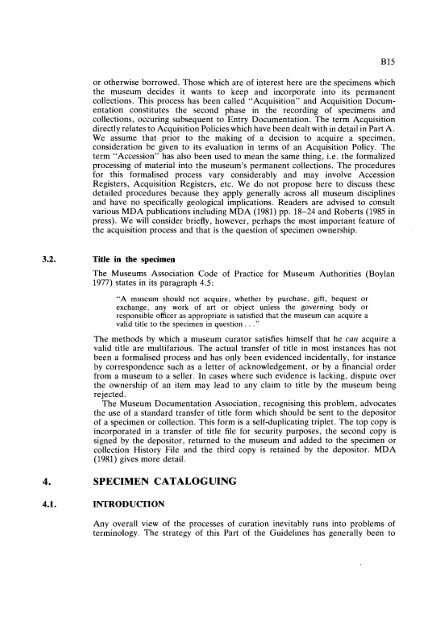GUIDELINES FOR THE CURATION OF GEOLOGICAL MATERIALS
GUIDELINES FOR THE CURATION OF GEOLOGICAL MATERIALS
GUIDELINES FOR THE CURATION OF GEOLOGICAL MATERIALS
Create successful ePaper yourself
Turn your PDF publications into a flip-book with our unique Google optimized e-Paper software.
or otherwise borrowed. Those which are of interest here are the specimens which<br />
the museum decides it wants to keep and incorporate into its permanent<br />
collections. This process has been called "Acquisition" and Acquisition Documentation<br />
constitutes the second phase in the recording of specimens and<br />
collections, occuring subsequent to Entry Documentation. The term Acquisition<br />
directly relates to Acquisition Policies which have been dealt with in detail in Part A.<br />
We assume that prior to the making of a decision to acquire a specimen,<br />
consideration be given to its evaluation in terms of an Acquisition Policy. The<br />
term "Accession" has also been used to mean the same thing, i.e. the formalized<br />
processing of material into the museum's permanent collections. The procedures<br />
for this formalised process vary considerably and may involve Accession<br />
Registers, Acquisition Registers, etc. We do not propose here to discuss these<br />
detailed procedures because they apply generally across all museum disciplines<br />
and have no specifically geological implications. Readers are advised to consult<br />
various MDA publications including MDA (1981) pp. 18-24 and Roberts (1985 in<br />
press). We will consider briefly, however, perhaps the most important feature of<br />
the acquisition process and that is the question of specimen ownership.<br />
Title in the specimen<br />
The Museums Association Code of Practice for Museum Authorities (Boylan<br />
1977) states in its paragraph 4.5:<br />
"A museum should not acquire, whether by purchase. gift, bequest or<br />
exchange, any work of art or object unless the governing body or<br />
responsible officer as appropriate is satisfied that the museum can acquire a<br />
valid title to the specimen in question. . ."<br />
The methods by which a museum curator satisfies himself that he caj1 acquire a<br />
valid title are multifarious. The actual transfer of title in most instances has not<br />
been a formalised process and has only been evidenced incidentally, for instance<br />
by correspondence such as a letter of acknowledgement, or by a financial order<br />
from a museum to a seller. In cases where such evidence is lacking, dispute over<br />
the ownership of an item may lead to any claim to title by the museum being<br />
rejected.<br />
The Museum Documentation Association, recognising this problem, advocates<br />
the use of a standard transfer of title form which should be sent to the depositor<br />
of a specimen or collection. This form is a self-duplicating triplet. The top copy is<br />
incorporated in a transfer of title file for security purposes, the second copy is<br />
signed by the depositor, returned to the museum and added to the specimen or<br />
collection History File and the third copy is retained by the depositor. MDA<br />
(1981) gives more detail.<br />
SPECIMEN CATALOGUING<br />
INTRODUCTION<br />
Any overall view of the processes of curation inevitably runs into problems of<br />
terminology. The strategy of this Part of the Guidelines has generally been to

















